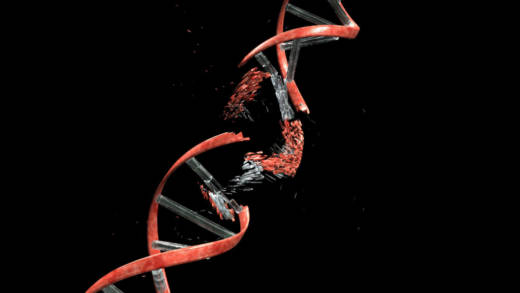The companies questioned whether the CRISPR-caused DNA damage reported in the new study applied to the kind of cells they’re planning to CRISPR. They emphasized that if genomic scrambling is at all common then it should also be seen in earlier forms of genome-editing such as zinc fingers and TALENs (but apparently isn’t). And they insisted they’re on the case.
“We’re not Pollyannaish about this,” said geneticist Tom Barnes, chief innovation officer at Intellia. For its mouse experiments, Intellia analyzes edited genomes for collateral damage both near the editing target and tens of thousands of DNA letters away, he said, but “we have not seen any [cancer-causing] transformation of these cells, even with all the edits we’ve introduced.”
In a statement, Editas spokeswoman Cristi Barnett said the possibility of genetic chaos from CRISPR is “an interesting topic” that the company “actively examine[s].” The reported DNA havoc, she said, is not “specifically problematic in our work to make CRISPR-based medicines.” CRISPR Therapeutics did not respond to requests for comment.
Academic scientists were less dismissive of the new study, in Nature Biotechnology. One leading CRISPR developer called it “well-done and credible,” “a cautionary note to the [genome-editing] community,” and consistent with other research showing that the DNA cuts that CRISPR makes, called double-stranded breaks, “can induce the types of genomic DNA rearrangements and deletions they report.” He asked not to be identified so as not to jeopardize business relationships with genome-editing companies.
But just as critics of last month’s studies asked why, if CRISPR’d cells can initiate cancer, no CRISPR’d mice had turned up with tumors, so scientists raised similar questions about the new genomic havoc finding: Why don’t scientists see it when they analyze the DNA of CRISPR’d cells?
“You find what you look for,” said Bradley. “No one is looking at the impact [of these DNA changes] on downstream genes.”
And few studies conduct full-out genome sequencing of CRISPR’d cells. Moreover, scientists typically search for one form of the collateral damage the Sanger study found — deletions of thousands of DNA bases (the double helix’s famous A’s, T’s, C’s, and G’s) — using a standard technique called PCR, which makes millions of DNA copies. But to work, PCR must attach to a “binding site” on DNA; CRISPR sometimes deletes that binding site, said Bradley, whose team used a different technique to analyze the double helix for collateral damage from CRISPR.
The Sanger scientists didn’t set out to find collateral DNA damage from CRISPR. As they investigated how CRISPR might change gene expression, a “weird thing” showed up, Bradley said: The target DNA was accurately changed, but that set off a chain reaction that engulfed genes far from the target. The scientists therefore changed course.
When they aimed CRISPR at different targets in mouse embryonic stem cells, mouse blood-making cells, and human retinal cells, “extensive on-target genomic damage [was] a common outcome,” they wrote in their paper. In one case, genomes in about two-thirds of the CRISPR’d cells showed the expected small-scale inadvertent havoc, but 21 percent had DNA deletions of more than 250 bases and up to 6,000 bases long.
Since therapeutic uses of CRISPR would edit the genomes of billions of cells in, say, a patient’s liver, even rare DNA damage “makes it likely that one or more edited cells … would be endowed with an important [disease-causing] lesion,” the scientists wrote.
Nature Biotechnology took a year to publish the paper, after asking Bradley numerous variations of “are you sure?” and “did you consider this?” and asking him to run additional experiments, Bradley said. The results all held up.
The one U.S. clinical trial using CRISPR’d cells began recruiting patients this year. It will use CRISPR to make immune cells, removed from patients with any of four types of cancer, attack telltale molecules on the tumor cells’ surface. Asked what genome analysis he plans to do, lead investigator Dr. Edward Stadtmauer of the University of Pennsylvania said, “We are doing extensive testing of the final cellular product as well as the cells within the patient.”
The possibility of adverse consequences from CRISPR’d cells has caused some company officials to argue that if, say, their therapy cures a child of a devastating disease, but increases her risk of cancer, that might be an acceptable trade-off.
That argument may well prevail. In 2003, however, when a boy in a gene therapy trial in France developed leukemia because the repair gene landed in the wrong place in his genome and activated a cancer-causing gene, it shut down gene therapy development on both sides of the Atlantic for years.
